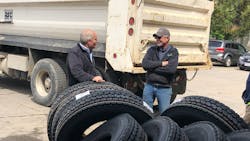As crazy and unpredictable as the tire industry can be, there’s a long series of predictabilities that can be directly traced to the growth and profitability of most dealerships.
If you have participated or are participating in 20 Groups, you’ve likely heard and seen the timelines we use to describe what’s happening in your shop and what needs to happen in order to move beyond your current level of performance.
Getting a profitable operation up and running in the first few years can be tough. Advancing beyond the industry average net performance can be even tougher, maybe even impossible, if you don’t have the influences around you to keep you from continuing to operate like you’re a new owner/operator.
At a recent D2D Development Group meeting, one of the biggest barriers to continued growth and success was highlighted. Hang on until the end of this column and it will all come together.
Newer dealership owners and/or those not making money have trouble with cash flow, find that payroll is perilously close to not happening and feel immense stress on a daily basis. These owners often wonder why they don’t just hang it up and get out of the tire industry.
While there are a million things on the table to help move into a taste of profitability — like car count, expense reduction and a revamp of payroll — operational efficiencies should be in hyper focus.
Let’s say you did those things and are ready to move forward. Cash flow is getting better, payroll seems less perilous and stress is still high, but you’re earning a few wins here and there. Let’s say you’re now in the 1% to 3% net profit range. You’ve earned a decent car count and it’s time to start focusing on experiences — both customer and your team members’ experience. At this stage, improving your operational efficiencies with a defined vehicle inspection process and memorable customer experience should jump to the front of the priority line. Handle those, raise your labor rate again, get better margins on your parts, refine your payable and receivable processes and target a demographic missing in your customer database and you’ll likely take a few steps forward toward doubling down on your current net.
Fast forward and your cash flow is much better. Payroll is not only not perilous, but you likely have room to start taking your “fair share” as an owner. Operating at 4% to 7% net, you’ve joined the masses and are at the industry average. Here you finally feel a reduction in stress and can start working a bit more on the business, rather than in it. Your community, via word of mouth, has finally started to positively impact your car count and you begin focusing on your sales process, hiring standards and job standards. These actions will help greatly, but this is where things get a bit sticky and many owners get stuck. Remember the predictabilities I mentioned earlier? Well, here we go.
The road to 4% to 7% has likely been the result of your heavy influence in every single aspect of your business. Customers and team members know they can ask you for help or a solution and you’ll handle it. You’ve effectively mastered the art of the “ask role.” You alone are the chief operating and executive officer of your own finely crafted position, aimed at keeping you right where you are.
The good news is work is fun again and your efforts in working a bit more on your business are paying off. For the next step, you start fine tuning. You start having some fun with processes and making small incremental changes that make for year-long improvements. You also give someone on your customer service team an elevated role with more responsibility. That way you can do what you know you need to do by working on your business and deciding how you’re going to reinvest your profits.
However, the only problem is that you’re still CEO of the masterful “ask role” you have created. Customers still ask for you by name and you help them. A tech has an issue and glances straight beyond your service manager and directly to you. This role is now, with fantastic predictability, the single greatest barrier — among many — standing between you and advancing beyond the masses into industry-leading profitability.
How do you fix it? Simple. You take yourself out of the “ask role” and start operating your business like you’ve learned to. Furthermore, replace the “ask role” with team-centric systems that allow your business to thrive without you there.
And don’t forget that if you are stuck in the “ask role,” our industry is full of awesome fellow tire dealership owners who can help you via a peer-to-peer group.
About the Author

Randy O'Connor
Tire and auto industry veteran Randy O’Connor is the Owner/Principal of D2D Development Group (Dealer to Dealer Development Group.) He can be reached at [email protected]. For more information, please visit www.d2ddevelopmentgroup.com.
